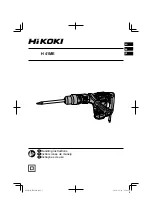
English |
23
Bosch Power Tools
1 619 P09 071 | (29.6.10)
Approved Grinding Tools
All grinding tools mentioned in these operating
instructions can be used.
The permissible speed [min
-1
] or the circumfer-
ential speed [m/s] of the grinding tools used
must at least match the values given in the table.
Therefore, observe the permissible
rotation-
al/circumferential speed
on the label of the
grinding tool.
Dust/Chip Extraction
f
Dusts from materials such as lead-containing
coatings, some wood types, minerals and
metal can be harmful to one’s health. Touch-
ing or breathing-in the dusts can cause aller-
gic reactions and/or lead to respiratory infec-
tions of the user or bystanders.
Certain dusts, such as oak or beech dust, are
considered as carcinogenic, especially in
connection with wood-treatment additives
(chromate, wood preservative). Materials
containing asbestos may only be worked by
specialists.
– Provide for good ventilation of the work-
ing place.
– It is recommended to wear a P2 filter-
class respirator.
Observe the relevant regulations in your
country for the materials to be worked.
f
Prevent dust accumulation at the work-
place.
Dusts can easily ignite.
Operation
Starting Operation
f
Observe correct mains voltage! The voltage
of the power source must agree with the
voltage specified on the nameplate of the
machine. Power tools marked with 230 V
can also be operated with 220 V.
Switching On and Off
To
start
the power tool, press the On/Off switch
5 forward and then down.
To
lock-on
the pressed On/Off switch 5, push
the On/Off switch 5 further forward.
To
switch off
the power tool, release the On/Off
switch 5, or when it is locked, briefly press the
On/Off switch 5 and then release it.
f
Check grinding tools before using. The
grinding tool must be mounted properly
and be able to move freely. Carry out a test
run for at least one minute with no load. Do
not use damaged, out-of-centre or vibrating
grinding tools.
Damaged grinding tools can
burst and cause injuries.
Speed preselection
The required speed can be preselected with the
thumbwheel 4 (also while running).
The required speed depends on the material
and the working conditions and can be deter-
mined through practical testing.
Constant Electronic Control
Constant electronic control holds the speed
constant at no-load and under load, and ensures
uniform working performance.
max.
[mm]
[mm]
D
b
d
[min
-1
] [m/s]
180
–
–
3000
80
100 30 M 14
3000
45
D
D
b
d
Thumbwheel 4
No-load speed (min
-1
)
1
750
2
1200
3
1600
4
2000
5
2400
6
3000
OBJ_BUCH-1284-001.book Page 23 Tuesday, June 29, 2010 12:51 PM
















































